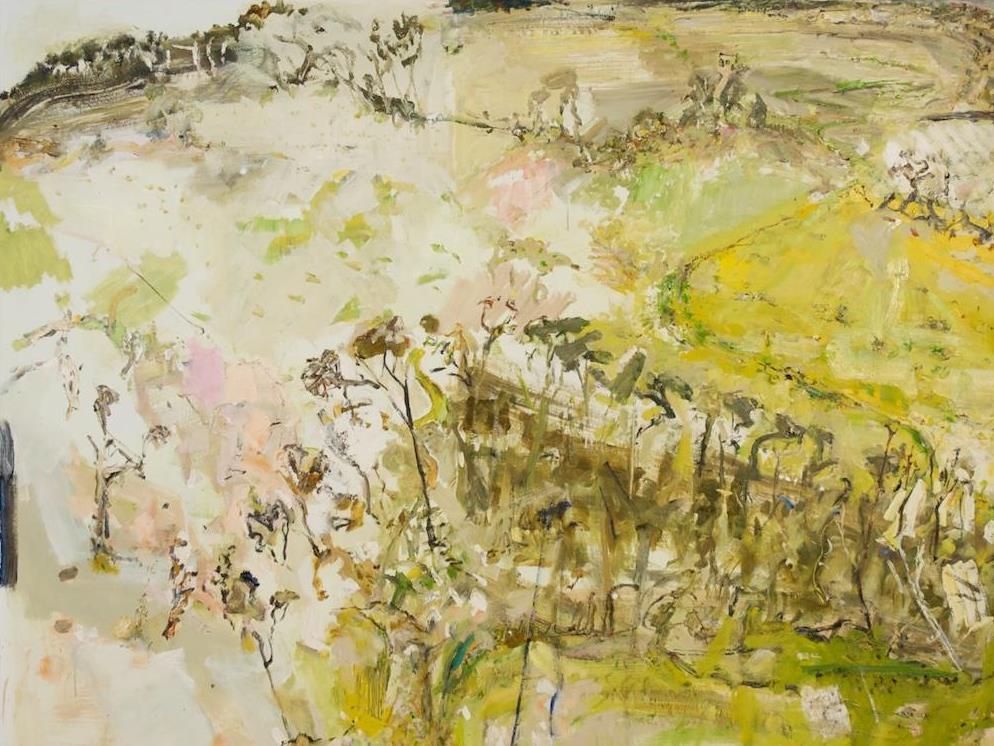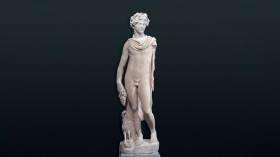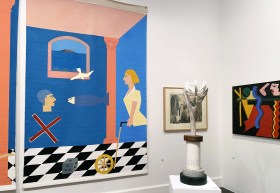Detail of Walker’s painting The Badja; courtesy the artist and Utopia Art Sydney
This exhibition doesn’t pretend to make any grand statements – it is simply an honest, intimate and focused engagement with landscape. It has been staged by Utopia Art Sydney to coincide with John R Walker’s survey exhibition at Orange Regional Gallery, titled Terroir: Big Land Pictures, thirteen expansive canvases that span over a decade of painting of an even bigger landscape, that of Braidwood in the Southern Tablelands of NSW.
The Utopia show both narrows and expands that vision. It tracks that landscape of Walker’s home out to Broken Hill and back to the Darling River and the Doughboy Hills, located about 25 kms from Braidwood on a ridge high over the Shoalhaven Valley; and it describes this landscape prolifically over the past year.
Walking into the exhibition it is a wash with colour and gesture – limestone whites emerge out of verdant almost phosphorescent greens and baked ochres. It is the kind of glow we have been tutored to expect of the Australian landscape bathed in light and vast openness, from Arthur Streeton’s Golden Summers and Arthur Boyd’s Shoalhaven paintings to Fred Willilams and John Olsen’s unique painterly language.
And yet while we intuitive recognise these triggers, Walker’s language is his own – lyrical in its mark making and flirting with an abstraction that removes us enough from the landscape and its history. It does not take one long to realise this is a very intimate understanding.
Among the stand out works are The Badja, (2014) (pictured top) and Doughboy Morning, (2013/14), where you seemingly rise above, at the same time as looking through and across, this landscape. There is a strange physicality in viewing them. Space is used by Walker in an interesting way. For example, Doughboy Morning, scoops and swoops around a vacant zone in the painting, playing off the disorientating quality of the Australian landscape and its isolation without calling on clichés.
Doughboy Track (2012) is the least successful of the paintings, with two parallel yellow lines carving their path through the landscape with a clumsy strength. I suppose conceptually their discord with the landscape speaks of the roads themselves, ill considered and aggressive in their gesture. But Walker does not strike me as a conceptually-driven painter. His paintings are all heart and connective tissue, almost like they have grown out of his personal journeys and stories, in the same way that we consider Aboriginal painters to hold a connection to land.

Doughboy Track with its distinctive yellow road carving the landscape; courtesy the artist and Utopia Art Sydney
When you compare it to the painting Doughboy V (2013), there is almost an ethereal quality at play. It reminds me of Chinese landscape painting, where the negative space acts as a device in building narrative. It is less driven by our Western understanding of perspective; here the centre of the painting pushes back with Turner-esq atmosphere rather than framing the scene. It is almost as though Walker invites us to fall into the work, to fill in the blanks and journey beyond its reaches.

Doughboy V with its distinctive use of space; courtesy the artist and Utopia Art Sydney
Walking played another key role in this exhibition in a suite of gouaches titled Badja Walking. Walker described, ‘Badja is really the first place where I wandered for days up and down valleys painting. It has beautiful swampy, sphagnum moss plains and open grassy alpine woodlands where navigation is easy.’
That ease enters these quick sketches. They are collected details of a site, often with different vantage points over time, that together become a landscape. After all, landscape is experienced that very way.

In this suite, two pages sit within a frame with their images slightly misaligned, at time a line calling them into register. The same technique is used in the larger canvases but it is less obvious without the page break. They have a quality of being mapped; one’s eye travels across the topography or geomorphology of the site, unfolding in its description as both site and Walker’s own language for it – slightly romantic, at times whimsical in his gestures and animations, but blunt and gnarly when called for.
It is at this point the viewer starts to understanding these works are as much about a play with paint as site. Walker is an intuitive and intelligent painter, moving through a full range of his medium from delicate washes, fleshy daubs, tendrils that drift off the brush, and crusts that rise like rock formations out of his landscapes.
What persistently defines John R Walker’s is the strength and delicacy in his painting. This is a landscape Walker has painted for over a decade and he knows implicitly, its changing colour, light, each rise to a ridge and valley that scoops the darkness of emotions. Simply this is John Walker’s place and it is a delight to journey through it.
4.5 out of 5
The End of all our Exploring
22 March – 26 April
2 Danks Street, Waterloo






